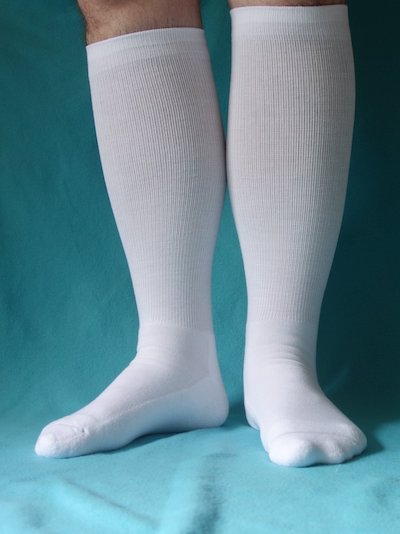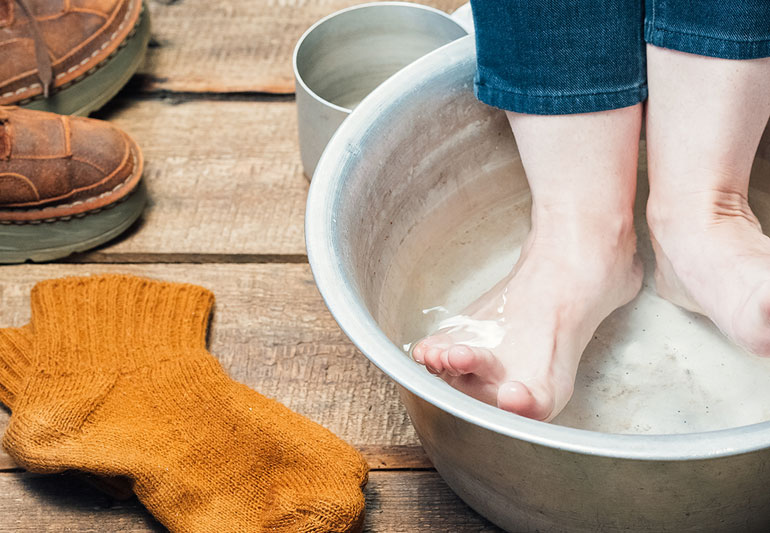Swollen feet can be unsightly and painful. The great news is that one simple, non-invasive, therapeutic treatment for swelling in the feet and ankles is the use of compression socks.
What are Swollen Feet?
Many people have experienced the annoyance and discomfort of swollen feet. And it’s not a surprise since the average person’s feet absorbs around 1000 pounds of force daily!
It can be due to a variety of reasons – injury, illness, diet, age, the weather or simply standing on your feet for long periods of time. Regardless of the reason, swelling in the feet and ankles can be not only unsightly but also painful.
The great news is that one simple, non-invasive, therapeutic treatment for swelling in the feet and ankles is the use of compression socks.
Let’s take a look at some of the problems that cause swollen feet and how compression socks might just make you wonder how you ever lived without them!
What Causes Them?
When your feet get swollen and uncomfortable on a regular basis, you first need to speak with your doctor. This is to ensure that you don’t have an underlying condition that’s causing it.
Swelling in the feet may be caused by:

- An Injury
- Pregnancy
- Lymphedema (Damaged Lymph Nodes)
- Chronic Venous Insufficiency (linked to Varicose Veins)
- Kidney Disease
- Liver Disease
- An Infection
- A Blood Clot
- Or Some Other Serious Conditions that must be treated prior to looking at the issue of swelling.
Once we’ve eliminated any underlying conditions or causes of swollen feet, we can take a look at why compression socks work well to prevent this swelling.
In general, gravity works against us by causing fluids to build up in the foot. This is especially true for individuals who spend a great deal of time standing up and aren’t able to put their feet up throughout the day.

How to treat them using compression socks?
As mentioned above, foot and/or leg swelling happens due to fluid build-up. Meaning, if there is no pooling of fluid in the lower part of the legs, then there would be no swelling. This is where the compression socks for swollen feet help.
Compressions stocking or compression socks place a squeezing pressure on the ankles and calves. As a result, the fluids are pushed back into the rest of the body.
Compression stockings are made with various levels of pressure. The socks squeeze your ankles from the outside in order to prevent the build up of fluid.
The stockings place a squeezing pressure on the ankles and calves that pushes the fluids back up into the rest of the body. The pressure also promotes better circulation that can help with swelling and other complications.
Both men and women can benefit from wearing compression socks. The best compression socks are made with graduated pressure that is tightest around the ankle and then loosens as it moves up to the calf or the thigh (depending on the length of the sock). This difference in pressure helps the flow of blood, thereby reducing swelling in the feet, ankles and leg.
What are they made of?

Most compression socks are manufactured to be durable and comfortable using breathable, stretchy materials such as nylon and elastane (Spandex).
What are their different ranges of pressure?

The pressure for compression socks is measured in millimeters of mercury (mmHg) which is the same measurement used in blood pressure cuffs.
Typical pressure ranges are as follows:
- 8-15mmHg — the lowest pressure used for compression socks, most often used for bed-ridden patients. Good for slight swelling.
- 15-20mmHg — can be purchased over the counter and may be used for flying or other travel. Good for mild swelling.
- 20-30mmHg — this mid-range, medical-grade pressure is fairly standard for everyday use for active people who want to manage swelling or varicose veins. Good for moderate swelling.
- 30-40mmHg — sometimes prescribed by doctors for those who have unique or more serious medical conditions. Good for severe swelling.
- 40-50mmHg — mostly used by doctors for severe wound management, lymphedema or severe circulatory conditions. Good for extremely severe swelling.
What to consider when choosing your own pair?
In selecting socks, consider these essential factors:
- Extra-Wide Fitting Socks – These socks are suitable for the right shoe size but have extra materials covering the leg and the foot of the socks to accommodate leg swelling (or swollen feet) and prevent blisters.

- Socks with Non-Elastic and Non-Constrictive Tops – Sometimes, the elastic on regular socks tend to bite into the leg and result in unsightly marking as well as pain and discomfort. Socks for ankle swelling or swollen feet should incorporate a non-restrictive, loose elastic.
- Toe-less Compression Socks — Some people prefer to use compression socks that don’t have enclosed toes so that their feet can breathe more easily when they are at home.
- Breathable, Durable Socks – Compression socks for swollen feet should be made from durable materials that allow for stretching as well as breathing. Consider nylon, polyester, elastane (Spandex) and other fabrics when choosing a sock for swollen feet.
Features to look for:

Using compression socks can be helpful for so many different types of people who struggle with swelling for a variety of reasons.
Here’s what to look for in compression socks for the best results:

- Graduated Compression Options: Use compression socks that offer different options of compression. This depends on what you and your doctor or pharmacist decide that you need to control your swelling.
- Sizing Options: Any compression sock company that claims they offer one-size-fits-all socks is doing it wrong! A perfect pair of compression socks need to be fitted to your specific needs and size. Especially if you have ankle swelling or leg swelling.
- Attractive Designs: Gone are the days of wearing your grandma’s white or beige cotton socks! Now you can fashionably wear your medically-designed sock needs with stripes, patterns, and all different colors.
- 100% Guarantee: Any company that sells you compression socks should back their product with a satisfaction guarantee return policy, so you can be sure you’ll get what you need for your swollen feet.
Leg Swelling Guidelines for Wearing Compression Stockings

If you’re wearing medical-grade compression socks or stockings, then you should certainly follow the instructions of your doctor or pharmacist as well as the manufacturer’s recommendations and guidelines.
Put On Your Socks First Thing In The Morning!
Leg, ankles and feet are usually the least swollen when you wake up. For the most part, medical professionals usually suggest putting compression socks on first thing in the morning, even before getting out of bed. This allows the socks to begin working before gravity can do its work and have a negative effect on your feet and ankles.
Most doctors agree that:
Compression Socks Should Be Worn All Day While You Are Upright and Active.
Compression socks can then be taken off at bedtime, or earlier in the evening if you are able to rest and prop your legs up and elevate them for some time before going to bed.

Sizing for Swollen Feet

When purchasing compression socks, you need to make sure they are the right size. Choosing the right size is important for the product to work effectively against the swelling in your feet and ankles. If they are too loose, they’ll only sag and won’t stop the swelling. If they are too tight, you’ll find they may cut off the circulation and actually do more harm than good.
In order to measure the proper size of compression socks, you’ll need to use a fabric measuring tape.

- Measure first thing in the morning when your feet are at their least swollen point.
- Wrap the tape above the foot and around the ankle and measure.
- Then wrap the tape around the largest part of your calf and note that measurement.
- Finally, while standing, measure the length from the backside of your calf, below the knee, to the floor.
Use above measurement tips to determine which size of compression socks you need to order.
Caring for your own pair

In order to get ultimate effectiveness and long-term use out of your compression socks, you’ll need to take care of them properly.
Be sure to follow the manufacturer’s instructions for care. These socks will normally require washing after each use (to avoid stretching as well as bacteria growth).
Washing should be by hand and they should be laid flat or hung to dry. Machine washing or wringing may stretch the socks, while tumble drying may shrink them.
NOTE: Because of the care involved with compression socks, you’ll want to be sure you have several pairs to make sure you have a clean pair when you need them! Plus, with all of the style and color options available in compression socks today, you probably won’t be able to avoid buying several pairs to match various outfits in your wardrobe!
How to Care for your Swollen Ankles and Foot

Of course, the initial thing one should do when you have a swollen foot is to consult a medical expert.
Here are some other tips you might consider in taking good care of your feet:
- Avoid walking barefooted. When you do this, you run the risk of damaging the sensitive skin on the feet. Socks can prevent further damage.
- Don’t cross your legs. Whenever you are in a car or a meeting, resist the urge to cross your legs. This reduces circulation below the knees which can cause swelling and other problems.
- Take a walk. Moving your body can help the fluids in your swollen feet to get moving too. So make sure to exercise regularly – even just by brisk walking.
- Wear well-fitted and suitable footwear. Avoid wearing shoes that are too small for you. They might cause pain and place undue pressure on your ankle swelling. Opt for functional loafers over the killer heel and your feet will thank you.
- Wear socks that come with the right features. Make sure you choose compression socks with the right sizing and with the right amount of pressure.
- Care for your toenails. Always keep your toenails trimmed and well maintained. Doing this will make you more comfortable and prolong the life of your socks.
- Seek medical care. Always talk to a medical professional before taking any risks with your health. Be sure to report signs and symptoms of your discomfort (such as swollen feet) to take the best care of your body.
Swollen Feet – Try these!
It’s true that compression socks for swollen feet might not change your life. But they certainly might help with swelling and pain–and that could at the very least change your day for the better! Check with your medical professional today to see if compression socks might work for your swollen feet or other concerns.
